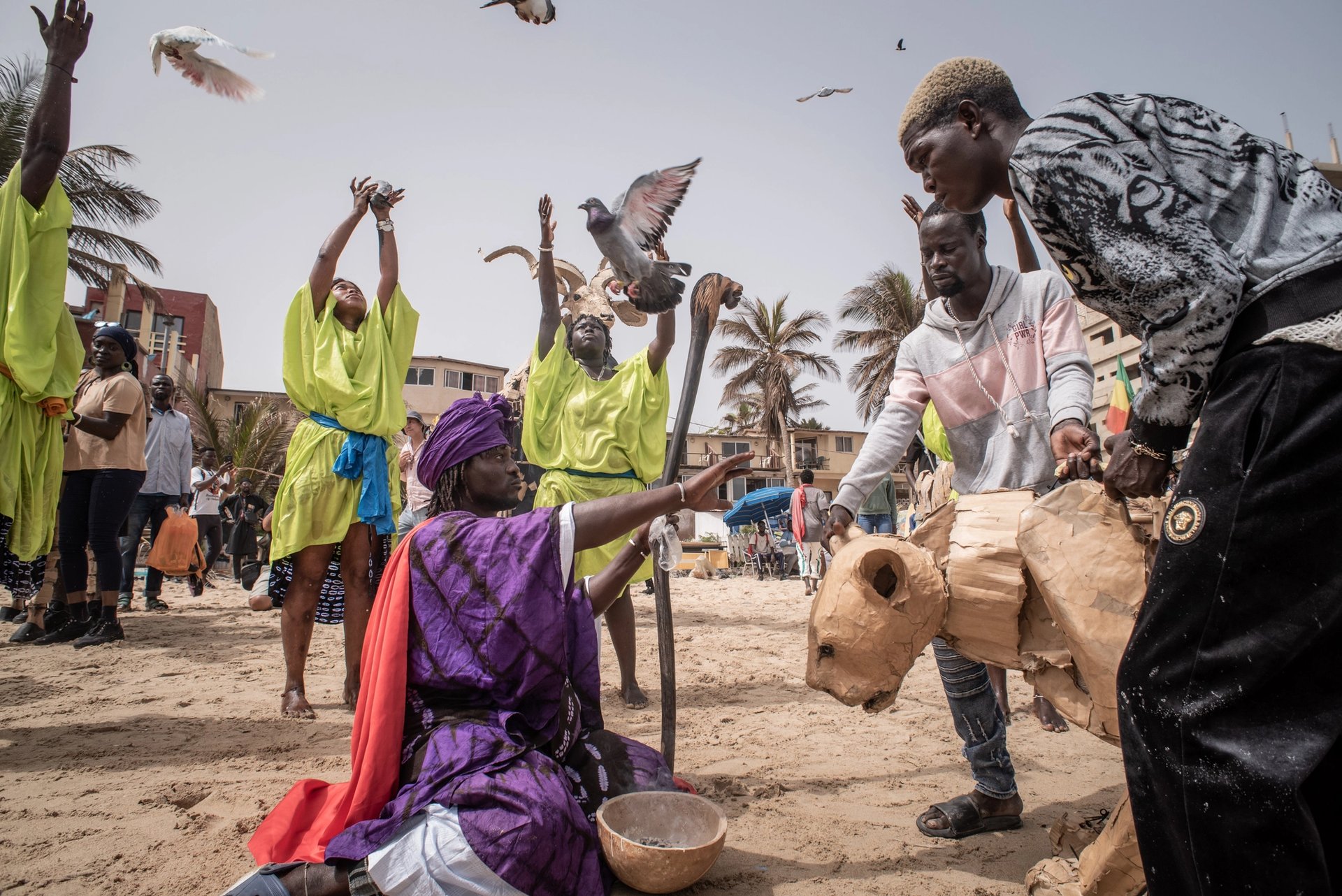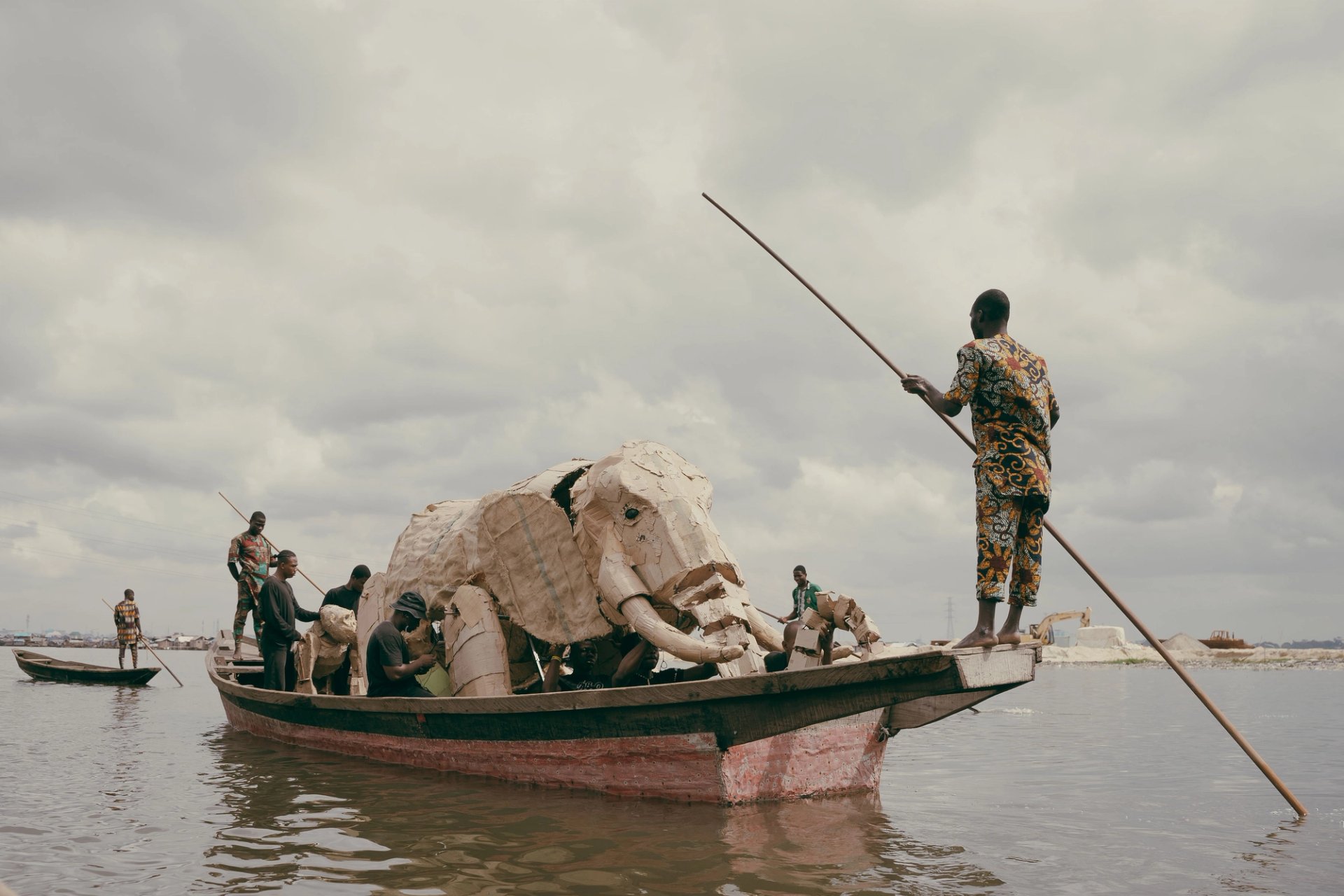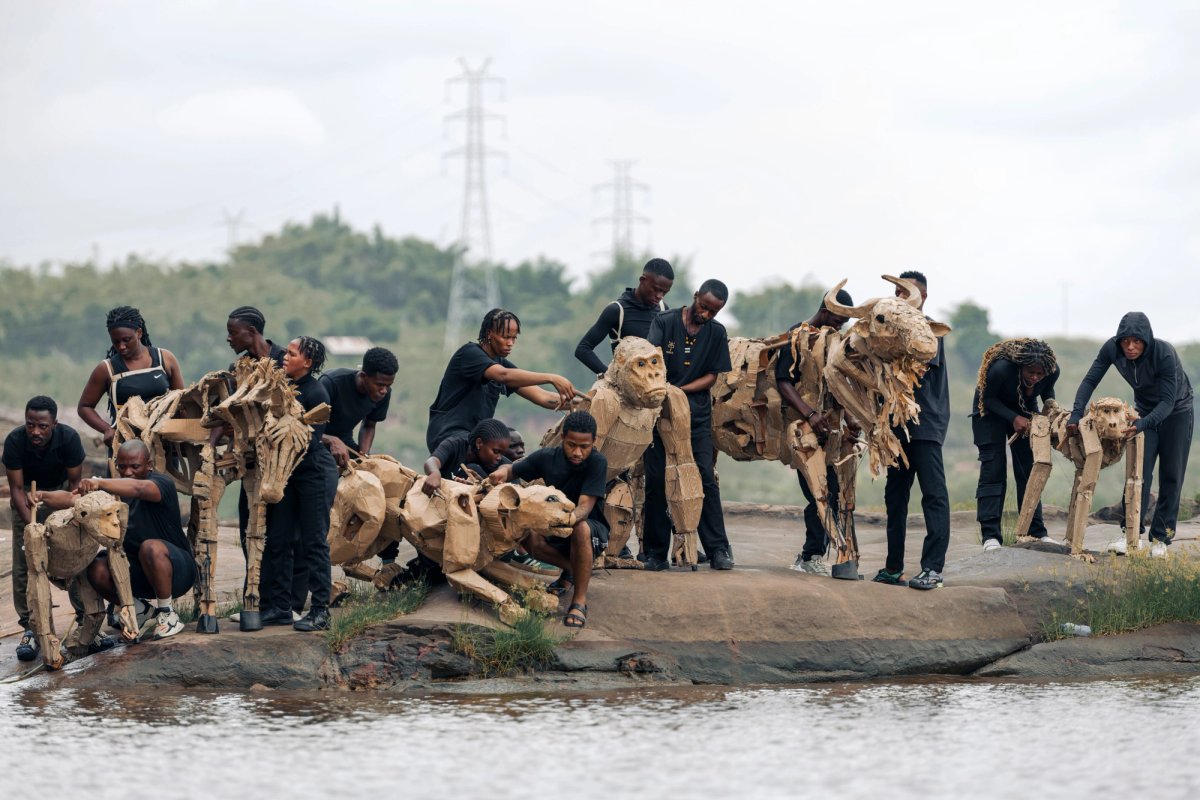A hugely ambitious mobile public artwork is currently traveling through Africa on its way to Europe and then up to the Arctic Circle in a call for action and a cry for change. On a scale appropriate to the climate and environmental crisis that it is aiming to highlight, The Herds is an expanding throng of life-sized moveable animal sculptures—the term puppet doesn’t do them justice—that is crossing continents on a symbolic flight from climate disaster. It is already stirring up communities and causing mild mayhem in the first batch of the eighteen designated cities that punctuate its four month odyssey.
The starting point was in April in the Congo Basin, where the initial group of creatures— including a giraffe, two zebra, a lioness, wildebeest, a gorilla, a baboon and a chimpanzee—emerged with their human operators from the forest to spend three days in and around Kinshasa. The pack paraded through the crowded city centre, engaging in a number of charged urban encounters, most notably with the local Nsango Mbonda drumming group and a throng of Congolese performers at the city’s landmark Echangeur Tower. From there The Herds progressed up along the Western Coast of Africa via Lagos and Dakar to Marrakech and Casablanca.
In June they will journey through Spain via Madrid and Barcelona to France (with one Italian stopover in Venice). Then it’s on to London and Manchester, followed by Copenhagen and Stockholm. The final destination is Trondheim in the far north of Norway where, on July 30, The Herds will perform an unspecified grand finale event which we are told “will embrace the ancient traditions of the Sami people” during the annual Olavsfest International festival.
Beauty and ferocity
Zoologically accurate and made entirely from naturally coloured recyclable materials such as cardboard, wood and twine, The Herds’ animals have been created by a number of South Africa-based artists. These include the Ukwanda Puppets and Designs Art Collective, Craig Leo, Simon Dunkley and Hansie Visagie as well as the project’s artistic director, Amir Nizar Zuabi. The award-winning playwright and director declares: “The Herds is an urgent response to the climate crisis…Through the beauty and ferocity of these life size creatures, we aim to spark dialogue, provoke thought, encourage engagement and inspire real change.”
This epic work of art is being realised in collaboration with a multitude of climate and arts organisations both local and international—including WWF International, The Global Rewilding Alliance, Wild Africa, TED Countdown and Arts Council England—along with countless individuals based in each location. As the journey unfolds, workshops running in association with some of the original creators will make and add additional local species, such as vervet monkeys in Nigeria, wolves and red deer in Europe and reindeer in Norway.
A key part of the project is also for this growing band of beasts (and accompanying humans) to interact with each and every new environment by spawning and participating in a rich range of events, encounters and interactions in every city it visits. The sheer spectacle of these huge cardboard interlopers, and their ability to manifest themselves in highly incongruous settings, is expected to generate widespread public (and online) attention.

Dakar, Senegal, 25-27 April
Jean-Baptise Joire
Performing around the world
Among these appearances have been an animated performative face-off with Ochai Ogaba’s Mud Art Company in Lagos, and an engagement with a work created by the Laotian choreographer Qudus Onikeku. In Senegal the animals met with a giant horned spirit goddess created by the artist Fabrice Monteiro, while in Casablanca there was a tumultuous encounter involving the circus artist Bader Haoutar and the pulsating percussive music of l’Ajhwach. Coming out of the Sahara desert into the Kasbah of Marrakech, The Herds was greeted by the wailing women of Aawniyat in a lament for nature, before some of the creatures charged through the historic Jemaa el-Fnaa.
Now The Herds is pausing before hitting Europe in June. A lot of their activities take place on the (ahem) hoof and will be announced in the next few weeks on their website, but future highlights include a new dance work by Compañía Nacional de Danza during their time in Madrid (6-8 June). Performed in the Centre of Creative Arts, once home to the city’s former cattle market, and a collaboration with the urban visual artist Suso33, the collaboration will investigate animal images in art from prehistoric cave paintings to Picasso.
During its single-day stopover in Venice on 17 June, The Herds coincides with Venice Biennale Danza under the aegis of artistic director Wayne McGregor, and here the animals are inspiring Biennale College dancers to perform a new piece by the Zimbabwean-born, Welsh-raised choreographer Anthony Matsena. When The Herds come to Paris between 20-22 June, the animals will be gathering around Notre Dame Cathedral and Hotel de Ville amidst the sounds of the city’s Fete de la Music.
In London the animals will arrive on 27 June by crossing over London Bridge. High-profile manifestations over their three-day stay will include a procession through the streets of London from Soho to the London Design Biennale at Somerset House, with a programme of events and activities along the way, and a public journey through Stratford via Queen Elizabeth Olympic Park whilst encountering performances by dancers from Sadlers Wells East. In Greater Manchester between 3-5 July, The Herds is partnering with The Factory International, and will also be a conspicuous presence during the opening of the Manchester International festival in the centre of the city.
Beyond the metropolitan
However, arguably as important as these two city stops is a significant partnership between The Herds and The Art Fund. This national charity is supporting more than 44 museums, galleries, trusts and historic houses across the UK to respond to The Herds, along with other international climate-action movements. These cultural spaces will generate a swathe of creative community projects that will extend into regions way beyond the metropolitan hubs of London and Manchester.
Already in the pipeline is a recycling initiative organised by the Watt Institution in Inverclyde, Scotland, in which local people are creating 3D-printed puppets of marine animals out of ocean plastic salvaged from local beaches. Meanwhile at Wentworth Castle in Yorkshire, there will be an outdoor installation of animals and insects created from recycled materials; while in collaboration with the Great North Museum in Newcastle, children aged 4-11 from travelling communities are making their own animal puppets based on themes of migration and movement.
In the south of England, projects inspired by The Herds range from a starling-inspired mass-human murmuration organised by the Stevenage Museum in Hertfordshire, to young people in Kent responding to the introduction of European bison into the region by creating their own life-size version out of recycled materials. The finished work will have a place of honour in the Herne Bay carnival parade on 9 August.

Makoko River, Lagos, 18-20 April
Kashope Faje, for 88 Life Studios
Practicing what you preach
By the time The Herds reaches its final destination of Trondheim, it will have covered more than 20,000 km and involved thousands of people worldwide. But, although the project is covering massive distances and staging multifarious and often spectacular events, throughout all of its activities The Herds is also committed to practising what it preaches and keeping its environmental impact to a minimum. Unlike many ostensibly green projects, right from the start sustainability has been baked into every aspect of its operations.
The animal sculptures are made using only upscaled natural and biodegradable materials—mainly cardboard and plywood—and are stored and transported in robust cardboard boxes which, when damaged, are broken up to repair the animal sculptures. Between cities the animals and The Herds’ team travel by rail and road, using as few vehicles as possible with team members taking flights only when other transport is not an option, most notably at the beginning and end of the entire project. Throughout, scrupulous emphasis is made on the least polluting forms of transport and the most sustainable production and digital systems.
Yet again, this excellent project confirms the ability of art to lead the way. Not only in its ability to engage audiences in communicating the most important of messages, but in showing how the maximum impact can be achieved using the most sustainable means.






